Alnitak 3

Alnitak 3 |

|
|
| Home | X-Objects | Stars | Habitability | Life | |
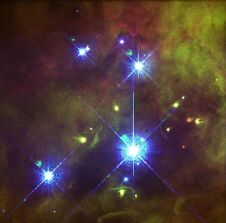 John Bally,
Dave Devine, and
John Bally,
Dave Devine, and
Ralph Sutherland,
STScI,
NASA
Larger false-color image.
Like Theta1 Orionis C, the brightest of the four
central stars of the
Trapezium
Cluster in Orion
(at left), Alnitak Aa is an
O-type
star located
around 800 light-years away. It is a blue
supergiant that is brighter than any of the stars
of the
"Solar neighborhood"
known to be
located within 100 light-years of Sol.
System Summary
Once thought to be around 1,500 to 1,600 light-years (ly) away, the Alnitak, or Zeta Orionis, system is now estimated to be located around 820 +/- 170 ly from Sol (based on a HIPPARCOS Plx= 3.99 +/- e_Plx= 0.79 mas). It lies in the south central part (5:40:45.5-1:56:34 for Stars Aab, J2000, or 5:40:45.5-1:56:33.3, ICRS 2000) of Constellation Orion (see chart and labelled photo), the Hunter. There, Alnitak can be found at: left or immediately southeast of the neighboring belt stars of Alnilam (Epsilon Orionis) and Mintaka (Delta Orionis); southwest of Betelgeuse (Alpha Orionis), northeast of Rigel, and northwest of Saiph (Kappa Orionis).
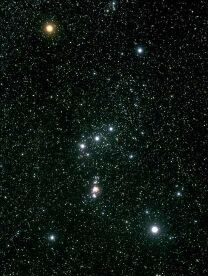 STScI,
NASA
STScI,
NASA
Larger image of
Constellation
Orion.
Alnitak is the leftmost
star of the three bright
stars in
Orion's
belt.
(another image with
enhanced
colors).
In the venerable Star Names: Their Lore and Meaning, Richard Hinckley Allen noted that its proper name, Alnitak (or Alnitah), is derived from the Arabic for Al Nitak meaning "The Belt" or "The Girdle" of Orion. Alnitak is the easternmost of the three stars of Orion's Belt, with Alnilam in the center and Mintaka in the west. All three were originally thought to be at a similar distance from Sol and (with Rigel, Saiph, and Meissa) probably formed at about the same time, around some 10 million years ago from the molecular clouds observed in Orion.
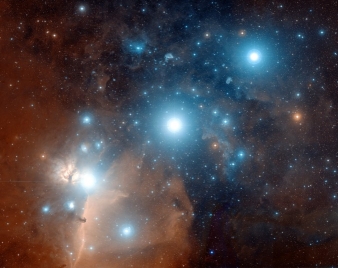 Davide De Martin
Davide De Martin
(Skyfactory),
Digitized
Sky Survey,
ESA/ESO/NASA
FITS
Liberator
Larger
composite image
of
Orion's Belt.
Alnitak is the
leftmost star
of
Orion's Belt
(more from
APOD).
In addition to wide binary companion Star B, Alnitak's primary also has a close stellar companion Ab, (USNO press release). However, the star (sometimes called "C") that has a separation of around 57.6" away is thought to be a optical companion. Alnitak lies in a region crowded with several dusty clouds of interstellar gas actively forming new stars, including the famous "Horsehead Nebula" to the south. The system is a member of the "Orion OB1 Association," where massive young objects with over 10 times the Sol's mass can be found in abundance (more on OB associations and stellar nurseries).
Alnitak Aa is a blue supergiant star of spectral and luminosity type O9.7 Ibe (with "peculiar" emission lines), where O-type stars are the hottest stars in the spectral sequence excluding white dwarfs. The star may have as much as 28 times Sol's mass (Hummel et al, 2000, in pdf), perhaps 20 times Sol's diameter (Remie and Lamers, 1982, page 87; as reported in Pasinetti-Fracassini et al, 2001), and around 100,000 times its bolometric luminosity, which is much greater than its visual luminosity of around 10,500 times Solar. The European Space Agency's astrometry satellite HIPPARCOS has measured Zeta Orionis Aab's distance from Earth to be around 820 light years, giving it an absolute visual magnitude of -5.25 (based on a HIPPARCOS Vmag= 1.74), somewhat under-luminous for stars of its class; however, these measurements may have been significantly affected by the presence of the recently discovered, dimmer close stellar companion Ab (described below). Even so, Alnitak Aa is the brightest O-type star in Earth's night sky (according to Professor Jim Kaler's excellent Stars' web page on Alnitak). Its 31,000-degree-Kelvin surface, however, radiates mostly ultraviolet wavelengths that are invisible to Human eyes.

NASA
Observatorium
Alnitak Aa is hotter,
brighter, and bluer
than even
Rigel
or
Spica.
See a discussion of
"core
helium burning"
as part of
stellar
evolution and death.
Type-O supergiants show strong stellar winds that produce optical spectral emission lines and thermal radio and X-ray emissions. How these stars produce high-energy X-rays, however, is still subject to intense research because they lack significant magnetic fields and are not sufficiently hot despite their very high surface temperatures. Alnitak Aa seems to generate and maintain magnetic loops like Sol, which is difficult for astronomers to explain. Although O-type stars have inner convection zones in their core, they are believed to lack outer convection zones, which astronomers considered necessary to create the hot and energetic plasmas confined in magnetic loops. Convection zones are internal regions where most of the energy is transported by fluid motions from hotter regions to cooler ones. Without such zones located near a star's surface, astronomers are currently unable to explain how high-density knots of X-rays could exist. On the other hand, shock waves created in the turbulent stellar wind flow are an important part of current theories. Like all O stars, Alnitak Aa's X-rays may come from a wind that blows from its surface at nearly 2,000 km (1,200 miles) per second, which produces x-rays when blobs of gas in the wind crash violently into one another (Donati et al, 2002; Waldron and Cassinelli, 2001, and 2000 in pdf; and CXC press release, 10/18/2000).
Massive stars use their fuel quickly and do not live very long. Although Alnitak Aa may only be around six million years old, hydrogen fusion may already have ceased at its core. The star will eventually become a red supergiant somewhat like Betelgeuse and will probably explode as a supernova. Useful catalogue numbers and designations for the star include: Zet Ori A, 50 Ori A, HR 1948/9, HIP 26727, HD 37742, BD-02 1338, SAO 132444, STF 774 A, and ADS 4263 A.
 Wayne R. Waldron, Joseph P. Cassinelli,
Wayne R. Waldron, Joseph P. Cassinelli,
EIT,
CXC,
NASA
Larger x-ray image of Stars Aab and B.
The primary has a wide stellar
companion B that is currently
around 580 AUs (or 2.3") away
(more on
x-ray
emissions).
In a wide orbit around the primary is a 4th magnitude visual companion, a B-type giant star that is currently separated by about 2.3 arcseconds (USNO press release, 4/15/1998). The pair orbits each other with a period estimated around 1,500 years long. According to old calculations (from J. Hopmann in 1967) cited in the Sixth Catalog of Orbits of Visual Binaries, Star "B" is separated on average from the primary by around 680 AUs (a semi-major axis of a= 2.728" at a distance of 817 ly), with an estimated orbital period of 1,508.6 years. Their highly circular orbit (e= 0.07) is inclined 72.0° from the perspective of an observer from Earth.
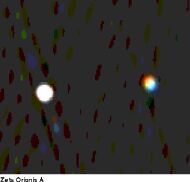 Christian
A. Hummel,
NPOI,
USNO
Christian
A. Hummel,
NPOI,
USNO
(Used with permission)
Larger, stacked
three-color image of Stars
Aa and Ab (where colors indicate motion).
In addition to a blue-white, stellar companion
B in a wide orbit, Alnitak Aa has another,
closer stellar companion Ab
(more).
In 1998, Star A was found to have a close stellar companion ("Ab") only around 11 AUs away (0.042" in February and March 1998 at a distance of 820 ly). The close companion is only two magnitudes fainter and would be easily visible to the naked eye from Earth if it was farther from its brighter neighbor. The relative motion of the inner stellar pair has been detected, which was "most likely due to their being gravitationaly bound with an orbital period of only a few years" (Hummel et al, 2000, in pdf; and USNO press release).
As Star Ab has a high visual magnitude (around 4) and a presumably youthful age of a few million years shared with the primary, it may be a late O-type main sequence dwarf (Hummel et al, 2000, in pdf). Hence, it should have a much greater mass (e.g., 23 times Solar), diameter, and visual luminosity (over 1,300 times Solar) than Sol.
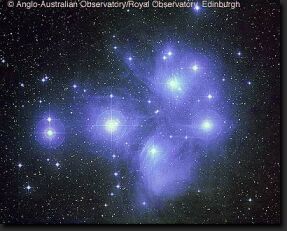 ©
AAO/ROE, photo by
David
Malin
©
AAO/ROE, photo by
David
Malin
(Used with permission)
Larger labelled image of Pleiades.
Alnitak B is a blue-white star
that is larger, brighter, and
hotter than Sirius A, like six
of the brightest stars of the
Pleiades
Cluster at left.
According to the Yale Bright Star Catalogue, 1991 5th Revised Edition notes entry for HR 1948 and 1949, Star B is a blue-white giant star of spectral and luminosity type B2 III. It may have 14 times Sol's mass, a much larger diameter, and around 1,100 times its visual luminosity, based on an apparent magnitude of 4.2 with an even greater bolometric luminosity due to the high ultraviolet emission of its spectral type (Hummel et al, 2000, in pdf). As with the inner star pair Aab, the orbit of an Earth-like planet (with liquid water) around Star B would be centered beyond the orbital distance of Pluto in the Solar System. Given the youth of the host star (which should be similar to that of the primary), moreover, such a planet is unlikely to have cooled sufficiently to have much surface water instead of steamon its surface. Useful catalogue numbers and designations for the star include: Zet Ori B, 50 Leo B, HD 17743, and ADS 4263 B.
This star is located at a position of 10 degrees and 58 arcseconds to the north of the primary (Hummel et al, 2000, in pdf; Abad et al, 1998; and Mason et al, 1998). It has an apparent magnitude of 9, for a visual luminosity of about 13 times Solar. According to Robert Burnham, Jr. (1931-93), it is probably not gravitationally bound to the Alnitak system.
Other Information
Try Professor Jim Kaler's Stars site for other information about Alnitak at the University of Illinois' Department of Astronomy. Additional information may be available at Alcyone Astronomical Software's page on Alnitak.
Constellation Orion is named after a legendary Hunter in Greek mythology. According to one story, Orion died after being stung by a scorpion. He was placed in the sky where he sets in the west while his slayer, Constellation Scorpius, raises in the east. Followed by his two dogs, he is now fighting the bull Taurus. According to another story, however, Orion was banished to the sky by the Gods after boasting of how many animals he would kill (to impress Eos). Now he and his dogs, constellations Canis Major and Minor, chase the constellations representing animals but can never catch them. For more information and an illustration of the constellation, go to Christine Kronberg's Orion. For another illustration, see David Haworth's Orion.
For more information about stars including spectral and luminosity class codes, go to ChView's webpage on The Stars of the Milky Way.
© 2002-2011 Sol Company. All Rights Reserved. |